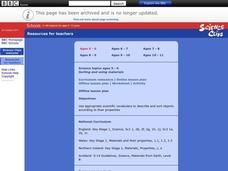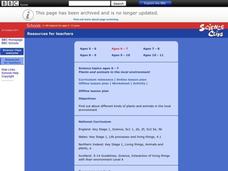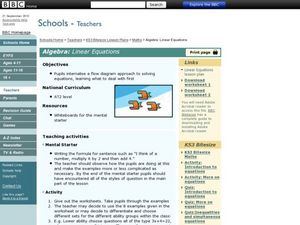Curated OER
Friction
Students are introduced to the concept of friction. Using that information, they discover ways in which friction can be useful. They participate in different activities to see fricition in action. They complete a grid worksheet and...
Curated OER
Sound and Hearing
Students form an understanding that there are many different types of sound. The core concepts are presented in the most basic form for elementary school. Also students investigate how sound travels.
Curated OER
Sorting and Using Materials
Students practice sorting and classifying objects. In groups, they choose a variety of materials and describe how each one looks and feels. They must agree on how to classify each object and share their groupings with the class. They...
Curated OER
Light and Shadows
Young scholars observe and record the apperacne of shadows and how their position and shpae changes during the course of the day. Students measure and record the length oof a partner's shadow at different intervals during the day. In...
Curated OER
Interdependence and adaptation
Students use keys to identify animals and plants in local habitats. Students are asked if they remember what the word habitat means. Students make a list of three different local habitats and brainstorm animals and plants they might...
Curated OER
Changing circuits
Students identify that there are conventional symbols to represent the components in circuits. Students use these symbols to draw diagrams of circuits. They are reminded that electric circuits can be drawn in diagrams using symbols. ...
Curated OER
Teeth And Eating
Students are introduced to several concepts about milk teeth and permanent teeth. They view photos of baby teeth, complete a worksheet that depicts their current tooth development and identify ways in which to care for permanent teeth.
Curated OER
Solids And Liquids
Students discuss the properties of solids and liquids. They complete a worksheet to show the boiling and melting points of several substances and consider if these factors affect how humans use materials.
Curated OER
Properties of Rocks
Students compare the properties of rocks. They identify objects made of rocky materials such as walls, sidewalks, etc. Students describe and group rocks based on their characteristics.
Curated OER
Earth, Sun and Moon
Students investigate that the sun is at the center of the solar system through role play. One student is the sun and one student is the Earth. The students then show how the Earth orbits around the sun. Students view a flashlight and...
Curated OER
Forces in Action
Students investigate different forces and draw arrows to signify specific directions of force. Students are then shown a brick and they are asked to draw a diagram which will include labels for the forces that are acting on the brick....
Curated OER
Forces and Movement
Students investigate the forces of pushing and pulling by participating in a whole group activity involving a toy car. Students then participate in a small group experiment involving a toy car, small weights and various materials....
Curated OER
Life cycles
Students identify and explain the parts of a flower and their role in the life cycle of flowering plants, including pollination, seed dispersal and germination using the Internet. Students will also study and discuss the key points and...
Curated OER
Plants And Animals in the Local Environment
Students observe the various living things they can find outside their playground making sure to look both on the ground and in the air. They develop a large poster Venn digram, as a class, of plants and animals that live in the air, on...
Curated OER
Reversible and irreversible changes
Students define the words "reversible" and "irreversible." They complete a worksheet that shows a number of changes. Students must decide which are reversible and which are irreversible.
Curated OER
Pushes and Pulls
Students discuss and investigate how various vehicles move. In a small groups, students then create a wheeled vehicle and find a way to make it move using various resources provided by the teacher.
Curated OER
Sports Shorts
Students put their writing on the World Wide Web. They write brief articles of 100 words or more on PE and sports related topics which are then put on the Internet on the Sports Shorts Webzine. They create sports related artwork or...
Curated OER
Alphabet Poem
Pupils create an alphabetized list about their favorite topic using the Alphabet Poem Brainstorming worksheet or creating a list on the board with the class. They think of a word that starts with their letters that relates to the chosen...
Curated OER
Algebra: Linear Equations
Young scholars investigate the mathematical concept of linear equations. They use codes to lead the discussion. The teacher makes clarification as necessary during the class discussion. The instructional activity includes dialogue to be...
Curated OER
Draw a Scientist
Students think to themselves about what a scientist might look like when they're working and then draw a picture of a scientist at work and discuss their drawings. They notice the number of men compared to women and other such...
Curated OER
Snakes
Students create a page in a classroom field guide to snakes. They each choose a different snake species to study in depth using the internet and books. The page contains information on habitat and adaptations of the snake as well as a...
Curated OER
European Union: Countries And Its Capital Cities
In this social studies learning exercise students complete a table showing the 25 members of the European Union and their capital cities. Sometimes students must fill in missing countries, other times students provide the capital city.
Curated OER
Really Useful List of 100 Irregular Plural Nouns in English
In this useful list of one hundred irregular plural nouns in English worksheet, learners pronounce and discuss all of the one hundred examples and then write ten more original examples on the lines provided.
Curated OER
Mix And Match Cards
In this grammar instructional activity, 5th graders create sets of cards which are grouped into 20 parts of speech. In each group there are about 60 cards with nouns, verbs, conjunctions, question words and other categories of words....

























